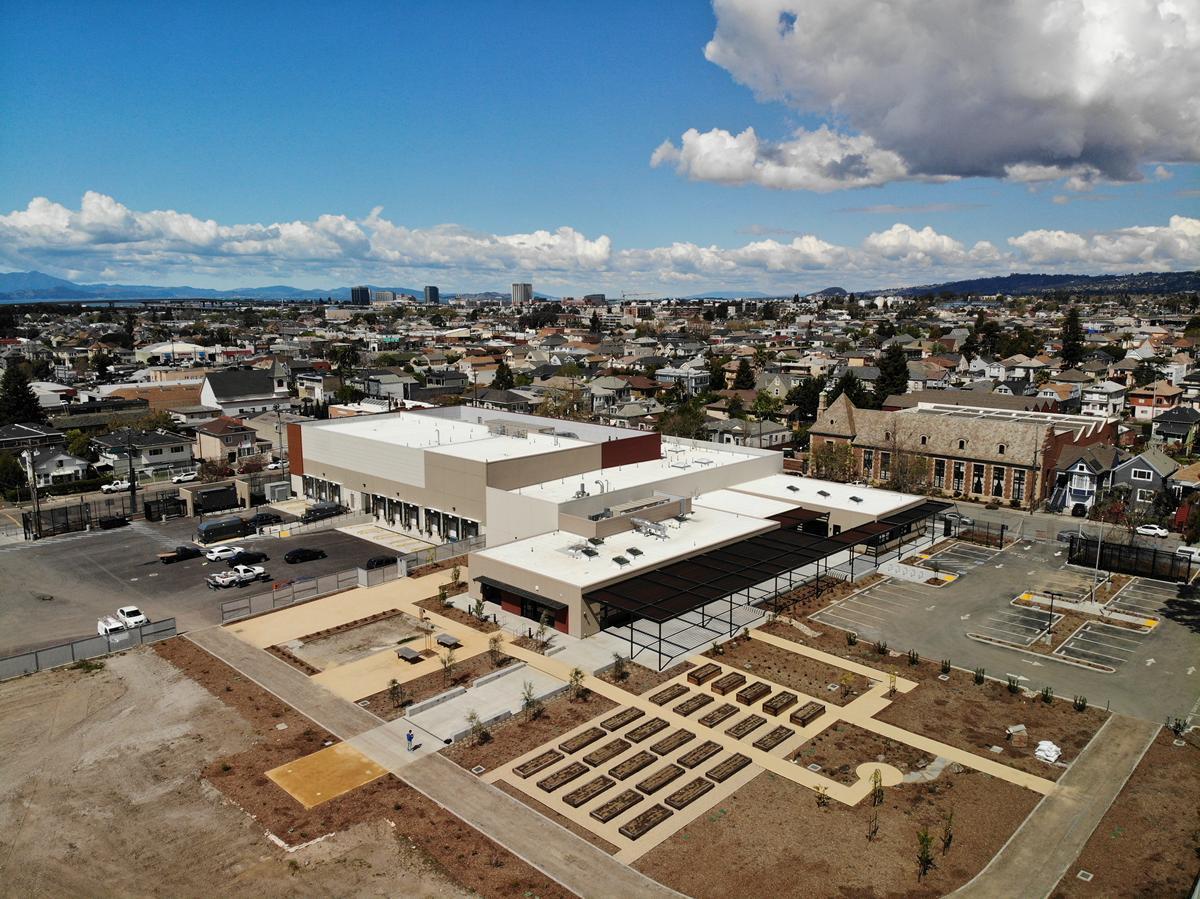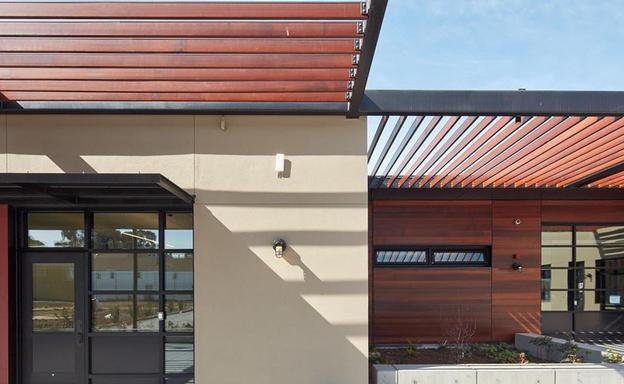Oakland Unified School District Central Kitchen, Instructional Farm, and Ed
Summarize the project's program, features, and achievements: Commissioned by the Oakland Unified School District and located in the heart of West Oakland, The Center was designed to support a central kitchen for district-wide food production, an education center focused on the culinary arts, and an urban farm to support 37,000 students across nearly 100 7 for Oakland Unified School District. Housed on one comprehensive site, the goal of the one-of-a-kind regional facility is to support health, wellness and education for the entire school district and to feed the nearly 30,000 students who participate in the district's free and reduced lunch program. The project was in the final stages of construction when the pandemic hit. Work had to be paused, but rather than let the 32,000 SF kitchen go unused, the Oakland Unified School District recognized the building’s potential to help the community. Reimagining the building as a community food distribution center, they quickly mobilized City planners and inspectors, the design and construction team, and the Alameda County Community Food Bank to open the facility early, with modifications to accommodate social distancing. The Food Bank together with the District’s nutrition services team, used The Center to prepare and distribute more than 10,000,000 student meals and provide more than 3,000,000 pounds of food to local families during the pandemic. Overaa was brought in to replace a previous general contractor for the lease-leaseback project. The project consisted of preconstruction and construction services for the new, 45,000 SF building. The facility includes 40,000 SF of kitchen space (concrete tilt-up), 5,000 SF (structural steel metal stud in-fill building) of administration offices, classrooms, demonstration prep spaces, administrative support spaces, and two acres urban farming area. Overaa self-performed the concrete work on the project, including foundations and the 23 tilt-up panels that were cast on site and managed 60+ subcontractors.
What obstacles were overcome related to the schedule, budget, program, specification, site, etc. on this project? OUSD had a very intentional community involvement plan from the beginning, including the goal of 50% local hire and 50% small local business participation on the project. Overaa joined forces with two small, local, minority-owned contractors, Eclipse Electric and Tulum Innovative Engineering (which is also Woman-owned,) in a Joint-venture mentorship arrangement. In addition, Overaa hired a community liaison (a single mother) to help increase communication about the project within the community. Rick Moore, Overaa’s Project Manager, said “I was able to hire five individuals from within a one block radius of the site.” Overaa’s project team attended monthly community meetings to update residents on the status of the project schedule and address any neighborhood concerns. Through outreach efforts, Overaa exceeded the goals with 68% small local business participation and 50% local hire. The early community spirit helped pave the way for cooperation, teamwork and expedient decision making among stakeholders throughout the challenging project, and ultimately helped the team pivot when the pandemic hit. The team was quickly able to get the blessing of the local health department and city inspectors to operate a temporary Community Food Bank on the premises. "This project sets the standard for a new model of scalability in food justice and community wellness issues," said Brent McClure, AIA, of CAW Architects. "The Center will stand as one of the best things Oakland Unified School District has ever done," said a district spokesperson.
Please communicate any engineering complexities or unique features of the panel design for this project. ? 60+ subcontractors contributed to the success of the project. Construction of the precast building was accomplished in two panel phases. First, foundations and slab-on-grade were completed in about three months to create Casting Beds for tilt-up panel formation on-site. Ten panels were tilted at a time in the first phase then the next thirteen panels followed. In all, twenty-three panels were tilted in three days. Quality Control for the Tilt-Up construction focused on lift and brace insert locations, embedments, and reveal detailing in addition to the quality control procedures typical to concrete construction. The project houses the first and only industrial kitchen and cold storage warehouse in the Western United States with an Ammonium and Carbon Dioxide Cascade refrigeration system. This environmentally friendly system required over 60 penetration sleeves to be installed in the 23 panels. All of the sleeves were coordinated and verified prior to pouring concrete resulting in ZERO core holes in the finished panels.
What is the potential for this project's impact on the community and/or environment? The facility uses 35 percent less electricity than comparable structures, thanks to extensive daylighting, carbon dioxide-based refrigeration, and waste heat recapture system. The facility includes Fully Integrated “Green” Technology HVAC Systems and is CHPS Pending. The project included Coordination and integration of nearly 450 kitchen equipment items and 20+ building operational systems, including: The state-of-the-art kitchen uses 450 different Kitchen Equipment items. The HVAC System is comprised of Air Distributions System (VAV’s, VFD’s, AHU’s. EF’s, FCU’s), Hydronic Systems (Chilled Water Systems, Heating Hot Water system, recirculation System, Heat Recovery Systems) Natural Ventilation Methods use Night Flush Operated by Building Management System (operable skylights & louvers) and a Heat Recovery System reheats the building Lighting Controls are managed by the Building Management System and are integrated with Emergency Power (Generator.) Other Integrated Building systems include a Refrigeration System to Utilize C02 and Ammonia in Lieu of Freon (Freon is known to have high environmental Impacts). Also integrated with a Leak system that detects high levels of C02/Ammonia The Fire Life Safety System monitors not only the Fire Alarm but also special systems such as (6) Fire suppression systems under exhaust hoods, a dry-air fire suppression System utilized in 8000 sf of Freezers and Palletized Racking systems, and standard wet pipe fire Suppression system. It also integrates with the Intrusion system.

Project Location
Oakland, CA 94608-4536
United States
TILT-UP ACHIEVEMENT AWARD
The Tilt-Up Achievement Awards were established to honor projects that use site-cast tilt-up concrete to introduce new building types, advance industry technology and provide unique solutions to building programs. Winning entries illustrate the variety, beauty, and flexibility of tilt-up construction.
ACHIEVEMENT
2023
The world’s greatest tilt-up structures are featured by the TCA as Tilt-Up Achievement Award Winners. Learn more >
Project Images
Project Team (TCA Members)
- General Contractor:
- Concrete Contractor:
- Architect:
- Engineer:
- Suppliers:
- Photographer(s):
- Asah Pearson
- Bruce Damonte
Project Specifics
- Project Category:
- Schools
- Building Types:
- Distribution Center
- Finishes:
- Applied Ornament
- Paint (Flat)
- Features:
- Embedded Items
- Reveals
- Insulation:
- Sandwich Panel (Composite)
- Environmental:
- Number of Floors:
- 1
- Tilt-Up Wall Area:
- 25,912 sq ft (2,407 sq m)
- Total Floor Area:
- 45,000 sq ft (4,181 sq m)
- Project Footprint:
- 45,000 sq ft (4,181 sq m)
- Tallest Panel:
- 41 ft 4 in (12.60 m)
- Widest Panel:
- 44 ft 7 in (13.59 m)
- Largest Panel:
- 1,780 sq ft (165.4 sq m)
- Heaviest Panel:
- 197,050 lbs (89,380 kg)








